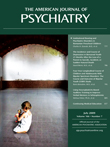Drs. Rao, Hammen, and Poland Reply
To the Editor: We appreciate the comments by Drs. Schütz and Sepehry. We agree with their statement that cigarette smoking is frequently associated with alcohol and drug use disorders and that it also may be a “gateway drug” to other substance use disorders. For example, in one review article (1) , the investigators reported that the prevalence of smoking in individuals with substance use disorder exceeded 75%. We also agree that most psychiatric instruments, including K-SADS-PL, do not assess nicotine dependence.
Nicotine dependence was not assessed in our study. However, cigarette consumption was documented both at intake and during follow-up assessments. Some of these data were presented at a scientific meeting (2) . Specifically, 20.5% of adolescents in the sample reported a lifetime history of smoking, and 9.9% reported current smoking at intake. Of the adolescents who had follow-up data, 28.6% reported smoking during follow-up. Consistent with previous reports, there was a higher prevalence of smoking in adolescents who reported drug or alcohol use than those without a history of drug or alcohol use, both at baseline and follow-up (three- to four-fold higher).
At intake, adolescents who smoked and adolescents who did not smoke did not differ significantly with respect to HPA activity (the primary predictor variable of substance use disorder during follow-up). When follow-up clinical data were incorporated, subjects who smoked persistently (those who smoked at both baseline and follow-up) had significantly higher HPA activity than subjects who did not smoke (2) . In addition, adolescents who did not smoke at baseline but initiated smoking during follow-up and continued to smoke regularly had higher HPA activity (measured at baseline) compared with non-smokers. These data suggest that elevated HPA activity might serve as a vulnerability marker for both nicotine-related as well as non-nicotine-related substance use disorders.
It was not possible to examine cigarette smoking as a potential mediator/moderator of the relationship between HPA activity and the development of substance use disorder because the onset of smoking did not always precede the initiation of alcohol or drug use. Again, there was a high co-occurrence of smoking and non-nicotine substance use at both baseline and follow-up. In our article, the effect of prior substance use on the development of substance use disorder was examined. Although prior substance use had a significant influence on the development of substance use disorder, the effects of HPA activity and stressful life experiences persisted after accounting for the effect of prior substance use. We agree with Drs. Schütz and Sepehry that future investigations should include more careful assessments of nicotine use. Such studies also should examine the complex relationships among nicotine use, neurobiological markers, psychosocial factors, and clinical outcomes.
1. Kalman D, Morissette SB, George TP: Co-morbidity of smoking in patients with psychiatric and substance use disorders. Am J Addict 2005; 14:106–123Google Scholar
2. Rao U, Hammen C, London ED, Poland RE: Vulnerability for cigarette smoking in adolescents: a diathesis-stress model, in Proceedings of the 13th Annual Meeting of the Society for Research on Nicotine and Tobacco. Austin, Tex, 2007Google Scholar



